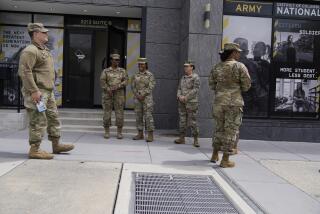U.S. to Dissolve 2 Army Divisions Based in Germany : Military: Affected will be the 3rd Armored and 8th Infantry. About 71,000 soldiers are involved as the Pentagon acts to halve troops in Europe.
WASHINGTON â The U.S. Army, marking the end of an era in Europe, will dissolve two divisions based in Germany, including the 3rd Armored Division, which routed Iraqi forces in the climactic desert tank battles of the Persian Gulf War, the Pentagon announced Thursday.
In a drive to halve its forces in Europe by the end of 1992, the Army plans to inactivate the 8th Infantry Division, the historic âHourglass Divisionâ established in 1917, as well as the 3rd Armored, also known as the âSpearhead,â which arrived in Germany in 1956 at the height of the Cold War.
For the record:
12:00 a.m. Aug. 17, 1991 For the Record
Los Angeles Times Saturday August 17, 1991 Home Edition Part A Page 2 Column 6 National Desk 1 inches; 36 words Type of Material: Correction
Wrong outfit--An article published in Friday editions incorrectly identified Gen. George S. Patton as the commander of the 3rd Armored Division. Patton commanded the 3rd Army, which spearheaded the surge of U.S. forces across France to Germany in 1944.
Between now and September, 1992, both divisionsâ combat memorabilia and other museum items will be boxed and shipped for storage to the Pueblo Army Depot in Colorado, the resting place for the remains of inactivated Army units. But the ceremonial âcolorsâ of the 3rd Armored Division are to be reactivated in the United States âat a date to be determined,â the Army said.
The move, which will affect about 71,000 soldiers, is the most significant step in the Pentagonâs plans to reduce U.S. forces in Europe by as many as 86,600 troops. Once the two units have left, only two divisions will remain in Europe.
Collectively, the 3rd Armored and 8th Infantry make up the Armyâs VII Corps, which also will be dissolved. The VII Corps was the command that engineered Gen. H. Norman Schwarzkopfâs âHail Maryâ flanking maneuver around Iraqi troops in Kuwait.
The inactivation of the two divisions and their parent corps is a powerful symbol of the U.S. militaryâs shrinkage in the wake of the Cold War. Also, it underscores the Pentagonâs effort to recast American forces to cope with a world in which regional conflicts like the Persian Gulf crisis assume greater importance.
When the 3rd Armored is reactivated in the United States, the resulting unit is expected to become part of the nationâs rapid-reaction âcontingency forces,â according to Maj. Pete Keating, an Army spokesman. Keating said that the 3rd Armored Division designation, along with the divisionâs crest, motto and campaign ribbons, probably will be assigned to an existing active Army unit inside the United States.
The two Army divisions that will remain in Germany are the 3rd Infantry and the 1st Armored, which together form the U.S. V Corps, headquartered in Frankfurt. The headquarters of 1st Armored, now in Ansbach, will be moved to Bad Kreuznach. The headquarters of the 3rd Infantry will remain in Wuertzburg.
Although the Army plans to reduce its rolls by 25% over the next five years, officials said that the inactivation of the two units and the reduction of troops in Europe are not expected to displace U.S. soldiers in large numbers.
âA lot of this doesnât involve troops leaving Europe or moving. It involves having some people stay in place and change their (unit) patches,â Keating said. âWeâre letting unitsâ strength go down through attrition and not backfilling. Those units remaining in Europe are realigning under a different division.â
Since the Army began withdrawing troops from Europe in 1990, 57,300 soldiers assigned to 146 units have been slated to come back to the United States.
The 8th Infantry , sometimes called the âPathfinders,â arrived in Europe in July, 1944. It fought in the Cotentin Peninsula in northern France, taking part in Operation Cobra, in which Gen. George S. Patton broke through German fortifications.
The 3rd Armored, which Patton commanded, entered Europe in the summer of 1944, sweeping across France and into Germany in the wake of the D-Day invaders. As it did so, the âSpearheadâ Division collected campaign ribbons in virtually all of the major campaigns of the European theater. After the war, the division was inactive. It was reactivated in the United States in 1947 and returned to Germany in 1956, remaining there ever since.
During periods of shrinkage, the Army uses a point system to decide which units to retire, Keating said. The scale, maintained by the serviceâs Center for Military History, takes into account the age of each unit, how long it has been in the Army and campaign credits it earned in the Indian Wars and the First and Second World Wars.
By those measures, Keating said, the 8th Infantry and the 3rd Armored divisions came in behind the 3rd Infantry and 1st Armored divisions.
Keating stressed, however, that both divisions are being âinactivatedâ rather than âdeactivated,â a step that would have dissolved them permanently. In planning its shrinkage, the U.S. military has taken pains to preserve the option of building up quickly in a national emergency.
More to Read
Sign up for Essential California
The most important California stories and recommendations in your inbox every morning.
You may occasionally receive promotional content from the Los Angeles Times.











